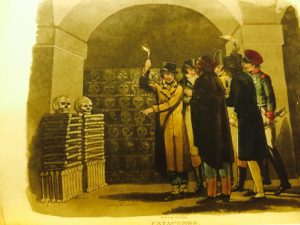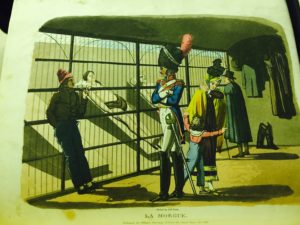by Elizabeth C. Goldsmith (Regular Contributor)
Soon after the end of the Napoleonic wars, curious English tourists started pouring into France, eager to see the sights after years of restricted travel to the Continent. Guidebooks were in demand. Writers and painters caught up in the burgeoning Romantic movement sought out picturesque scenes, ruins, and quaint regional costumes and behaviors. Illustrated travel accounts were particularly prized.
One of the more unusual of these was one written by Richard Brinsley Peake, an artist and engraver who later would become known as a playwright. Like most young English travelers in 1816, Richard was seeking not only adventure but also relief from the violence and death that had touched everyone during the era of Napoleon. Like other English travelers he was also fascinated to see what France looked like after surviving the tumultuous and bloody period that had begun with the Revolution. And he wanted to understand better what the French survivors were like.
 The illustrations in his book give an idea of what interested him most on his trip. The title says it is a book about “characteristic costumes” of France, but the substance is about much more than that. The opening scene seems to capture the ambivalence of the English visitor. He describes the nausea provoked by the voyage by boat across the channel and the amusement that he and his fellow seasick passengers inspired in the French who watched them land. He paints scenes from the street and public spaces, with almost every illustration including a reminder of the wars – a “mutilated” soldier, an old army officer in a coffee shop, begging children and widowed women holding babies. Almost every street scene includes men in uniform, no longer the soldiers of Napoleon’s army, but keepers of order from various branches of the civil guard.
The illustrations in his book give an idea of what interested him most on his trip. The title says it is a book about “characteristic costumes” of France, but the substance is about much more than that. The opening scene seems to capture the ambivalence of the English visitor. He describes the nausea provoked by the voyage by boat across the channel and the amusement that he and his fellow seasick passengers inspired in the French who watched them land. He paints scenes from the street and public spaces, with almost every illustration including a reminder of the wars – a “mutilated” soldier, an old army officer in a coffee shop, begging children and widowed women holding babies. Almost every street scene includes men in uniform, no longer the soldiers of Napoleon’s army, but keepers of order from various branches of the civil guard.
 Many of the tourist destinations that Peake singles out have to do with either illicit pleasures (gambling dens, “pleasure-gardens”, dance halls) or death (The Catacombs). On the latter, he comments: “Melancholy suggests itself, on arrival at the place which was appropriated to the remains of the revolutionary victims of 1792.” He moves from his ‘Catacombs’ chapter to one titled ‘The Morgue’. In 1816, the Paris morgue was a public place, where unidentified bodies were put on display. In the description of his illustration, he imagines that the officer contemplating a female cadaver was himself the person responsible for her death.
Many of the tourist destinations that Peake singles out have to do with either illicit pleasures (gambling dens, “pleasure-gardens”, dance halls) or death (The Catacombs). On the latter, he comments: “Melancholy suggests itself, on arrival at the place which was appropriated to the remains of the revolutionary victims of 1792.” He moves from his ‘Catacombs’ chapter to one titled ‘The Morgue’. In 1816, the Paris morgue was a public place, where unidentified bodies were put on display. In the description of his illustration, he imagines that the officer contemplating a female cadaver was himself the person responsible for her death.
His illustration of “a trip to Versailles” is not of the architectural wonder itself, but of a carriage accident encountered on the way. People and possessions are strewn pell-mell on the road. In his description of this scene, Peake notes the horses, who he says were left  behind in France by the Cossacks and then put to work by carriage drivers who recovered them. He imagines the beasts’ harsh treatment as punishment for their work during the wars: “The French driver vents his spleen upon his former enemy, accompanying each lash with the epithets of ‘Ah! Vilain Cossaque’ …”
behind in France by the Cossacks and then put to work by carriage drivers who recovered them. He imagines the beasts’ harsh treatment as punishment for their work during the wars: “The French driver vents his spleen upon his former enemy, accompanying each lash with the epithets of ‘Ah! Vilain Cossaque’ …”
After his return to England Peake turned more seriously to writing. His best known play is an adaptation of Mary Shelly’s Frankenstein, a work written in 1816 by a young woman herself heavily influenced by the scars left by Napoleon’s wars. In Peake’s staged version, Frankenstein is completely dehumanized. He is mute and more grotesque than in Mary Shelly’s description, like one of the cadavers the English traveler had viewed on his trip to Paris, returned to a monstrous life.
For further reading: French Characteristic Costumes, by Richard Brinsley Peake. London, 1816. (Several editions are available on Google Books.)
